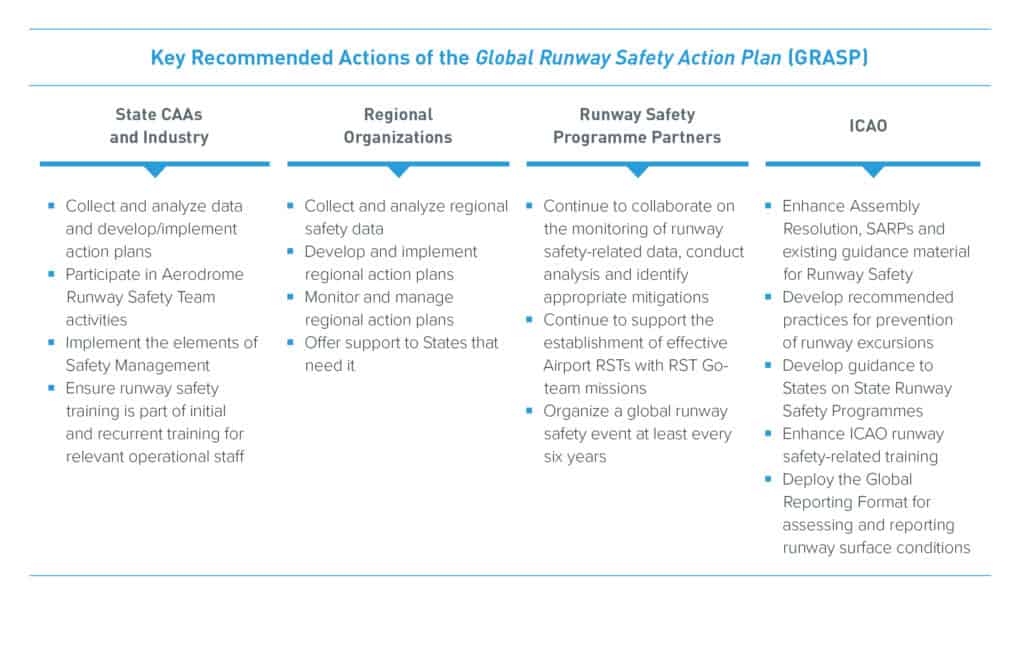With runway safety and in particular, runway excursions and incursions, remaining among civil aviation’s top safety risk categories, ICAO and its Runway Safety Programme Partners focussed when they launched a new Global Runway Safety Action Plan (GRSAP) at the Second Global Runway Safety Symposium (GRSS2017).
“Runway safety has been a global aviation priority for more than 15 years, and this new action plan is an important outcome of the detailed analysis of runway risk factors recently undertaken by ICAO,” commented ICAO Secretary General Dr. Fang Liu.
Runway safety-related accidents continue to represent the most significant source of aviation accidents worldwide and remain aviation’s number one safety risk category. Over the past eight years, about half of all aviation accidents reported to ICAO were runway safety related. Of those runway-related accidents, 35 percent were the result of a runway excursion, which occurs when an aircraft veers off or overruns the runway.
The good news in recent years is that accidents related to runway safety have resulted in relatively low numbers of fatalities, despite being the highest percentage of accidents. Much of that success can be accredited to the work of ICAO’s collaborative Runway Safety Programme and stakeholders’ efforts, such as the establishment of Runway Safety Teams at airports. Still, with global air traffic predicted to double in the next 15 years, it’s important to continue efforts to reduce runway-related risks to as low as possible.
“Regardless of the success achieved thus far, the numbers still reveal for us that we have more work to do to fully mitigate runway-related risks,” Dr. Liu emphasized.
The new GRSAP will guide the integrated activities of States, airports, airlines, air navigation service providers and manufacturers to implement runway safety improvement and risk reduction measures, with an overall objective of reducing runway safety related fatalities and accidents globally.
The GRSAP targets and timelines have been developed to support the runway safety targets already established under ICAO’s Global Aviation Safety Plan (GASP), which is looked to by aviation safety specialists all over the world as a high-level strategic tool to help align international actions and initiatives and avoid duplication of efforts.
 RUNWAY SAFETY PARTNER SUCCESSES
RUNWAY SAFETY PARTNER SUCCESSES
The GRSS2017 in Peru also provided an opportunity for ICAO and the Runway Safety Programme Partners to inform participants on the latest runway safety innovations and achievements. Airports Council International (ACI) informed participants about its Airport Excellence Programme (APEX), which is an on-site assessment of an airport conducted by industry peers and provides airports access to a global network of expertise with support, training and mentoring. The International Air Transport Association (IATA) described development of the second edition of their Runway Excursion Risk Reduction Toolkit (RERR). The Civil Air Navigation Services Organisation (CANSO) highlighted the launch of the latest edition of its Standard of Excellence in Safety Management Systems Maturity Questionnaire.
Eurocontrol used the opportunity of the GRSS2017 to launch its third edition of the European Action Plan for the Prevention of Runway Incursions (EAPPRI). This version recognizes the emergence of EU provisions intended to improve runway safety in Europe, while continuing to recognize ICAO Standards and Recommended Practices (SARPS), making it suitable for universal application.
It was also encouraging to see aircraft manufacturers continue to work on developing systems to prevent runway overruns. Airbus and Boeing presented their respective systems: Airbus’ Runway Overrun Prevention System (ROPS) and Boeing’s Runway Situation Awareness Tools (RSAT). The development of these systems and other runway safety technologies, such as the Engineered Materials Arrestor System (EMAS) installed at airports with short runways and small overrun areas, can greatly reduce the number of runway-related occurrences and their severity when they do occur.
The FAA Academy in partnership with ICAO TRAINAIR recently developed a standardized training package on “Runway Incursion Prevention” and conducted the first course in Lima ahead of the GRSS2017.

GLOBAL RUNWAY SAFETY ACTION PLAN (GRSAP)
In early 2017 the Runway Safety Programme Partners established the Runway Safety Action Plan Working Group (RSAP-WG) with the aim of reviewing the RSP achievements, objectives and priorities, and to develop the GRSAP.
Through a review and analysis of runway safety occurrence data, the RSAP-WG identified runway excursions and runway incursions as the top high-risk occurrence categories for runway safety. The GRSAP provides recommended actions for all runway safety stakeholders, with the aim of reducing the global rate of runway excursions and runway incursions.
In line with safety management principles, the RSAP-WG conducted an analysis of available runway safety accident and serious incident data and conducted a risk assessment to identify the runway safety high-risk categories, in order to prioritize the efforts of the Runway Safety Programme.
The analysis identified runway excursions as the highest-risk category with a total risk weight significantly higher than all other categories.
ICAO and Runway Safety Partners also identified runway incursions as a high-risk category. Although the number of runway incursion accidents reported between the period of 2008 to 2016 was low, the number of runway incursion incidents remains high (at a rate of one report per day according to IATA STEADES data). There is a very high fatality risk associated with runway incursion accidents. The collision between two B747s at Los Rodeos Airport, Tenerife, in 1977 was the result of a runway incursion and remains the worst accident in aviation history, with the highest number of fatalities.
The GRSAP provides recommended actions for all runway safety stakeholders, including ICAO and its runway safety programme partners, State Civil Aviation Authorities, Regional Aviation Safety Groups (RASGs), aircraft operators, aerodrome operators, air navigation service providers and the aerospace industry. Although the actions detailed in the GRSAP are aimed at reducing the global rate of runway excursions and runway incursions, regions, States and industry will have their own unique challenges, and should regularly conduct their own analyses to identify their own operational safety risks and appropriate mitigations.
